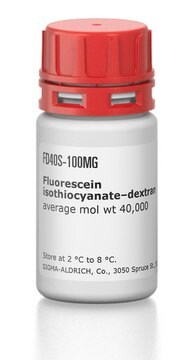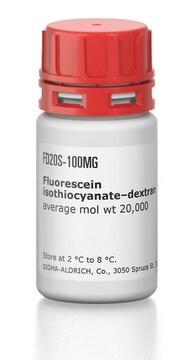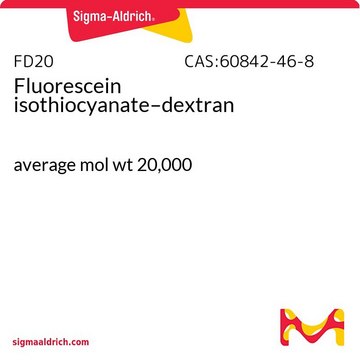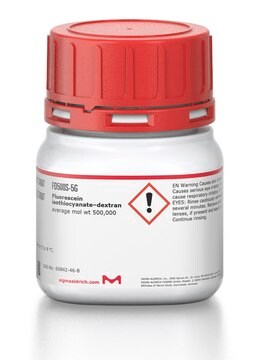FD40
Isotiocianato de fluoresceína-dextrano
average mol wt 40,000
Sinónimos:
FITC–Dextrano
About This Item
Productos recomendados
origen biológico
bacterial (Leuconostoc mesenteroides)
conjugado
FITC conjugate
formulario
powder
mol peso
average mol wt 40,000
Extensión del etiquetado
0.001-0.020 mol FITC per mol glucose
color
light yellow to dark orange
solubilidad
H2O: 25 mg/mL
temp. de almacenamiento
2-8°C
¿Está buscando productos similares? Visita Guía de comparación de productos
Descripción general
Aplicación
Nota de preparación
Otras notas
Palabra de señalización
Warning
Frases de peligro
Consejos de prudencia
Clasificaciones de peligro
Eye Irrit. 2 - Skin Irrit. 2 - STOT SE 3
Órganos de actuación
Respiratory system
Código de clase de almacenamiento
11 - Combustible Solids
Clase de riesgo para el agua (WGK)
WGK 3
Punto de inflamabilidad (°F)
Not applicable
Punto de inflamabilidad (°C)
Not applicable
Equipo de protección personal
Eyeshields, Gloves, type N95 (US)
Certificados de análisis (COA)
Busque Certificados de análisis (COA) introduciendo el número de lote del producto. Los números de lote se encuentran en la etiqueta del producto después de las palabras «Lot» o «Batch»
¿Ya tiene este producto?
Encuentre la documentación para los productos que ha comprado recientemente en la Biblioteca de documentos.
Los clientes también vieron
Artículos
Additional information about FITC-labelled polysaccarides including FITC-Dextran, FITC-DEAE-dextran (FDD), FITC-carboxymethyl-dextran (FCM-Dextran). This page discusses the impact of weight-average molecular weight on the respective molecule dimensions and other physical properties
Contenido relacionado
Dextran is a polymer of anhydroglucose. It is composed of approximately 95% alpha-D-(166) linkages. The remaining (163) linkages account for the branching of dextran.
Nuestro equipo de científicos tiene experiencia en todas las áreas de investigación: Ciencias de la vida, Ciencia de los materiales, Síntesis química, Cromatografía, Analítica y muchas otras.
Póngase en contacto con el Servicio técnico










